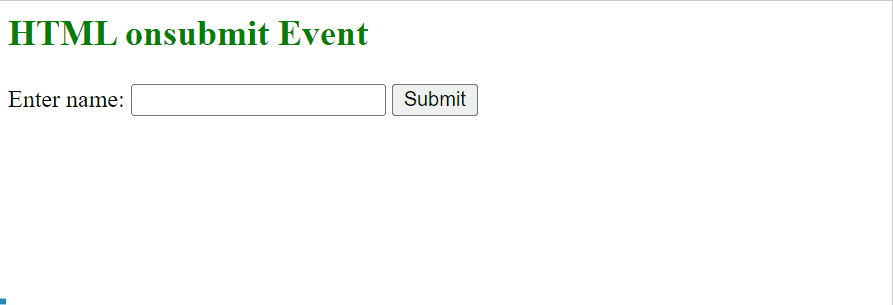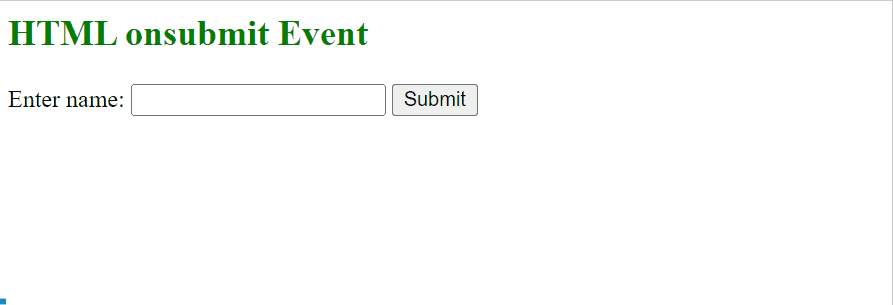This post explains the objective, working, and usage of the “onsubmit” event in JavaScript.
What is the JavaScript “onsubmit” Event?
The “onsubmit” event triggers when the form submits or when the “submit” button clicks. It invokes the associated JavaScript function to perform the defined task upon the event trigger.
Syntax
In the above syntax:
- element: It represents the HTML element.
- function(): It refers to the function that needs to be invoked upon the event trigger.
- myScript: It corresponds to the function definition to perform the specific task when the “onsubmit” event occurs.
Syntax(With “addEventListener()” Method)
In this syntax, the “addEventListener()” method attaches the “submit” event to execute the JavaScript function.
How Does “onsubmit” Event Work in JavaScript?
The “onsubmit” event works with the JavaScript function such that it returns its functionalities when the event triggers. It can be applied in different ways in the JavaScript function to perform various tasks.
HTML Code
First, an overview of the following HTML code:
<form id="formID">
Enter name:
<input type="text"><button>Submit</button>
</form>
In the above lines of code:
- The “<h2>” tag defines the subheading styled with the stated color.
- After that, the “<form>” tag is associated with id “formID” representing the input field of the content type as “text”.
- Also, a button is created to submit the form.
Note: The above-written HTML code is followed throughout the whole article.
Example 1: Applying the “onsubmit” Event to Display the Alert Box Based on Basic Syntax
This example displays the alert box upon triggering the “onsubmit” event with the help of a user-defined JavaScript function.
JavaScript Code
The JavaScript code is written below:
document.getElementById("formID").onsubmit = function() {demo()};
function demo() {
alert("Form Submitted");
}
</script>
In this code block:
- The “document.getElementById()” method accesses the form via its id “formID” and associates the “onsubmit” event with the function named “demo()”.
- After that, the function “demo()” is declared to display the “alert” box when the “onsubmit” event triggers.
Output
This output indicates that when the “onsubmit” event occurs upon button click, the alert box pops up displaying the stated message.
Example 2: Applying the “onsubmit” Event Based to Display Alert Box Based on the “addEventListener()” Method Syntax
This example utilizes the “onsubmit” event with the “addEventListener()” method to display an alert box upon the event trigger.
JavaScript Code
Consider the following JavaScript code:
document.getElementById("formID").addEventListener("submit", demo);
function demo() {
alert("Form Submitted");
}
</script>
The above code applies the “getElementById()” method with the “addEventListener()” method to fetch the form via its id “formID” and passes the “submit” event with the defined “demo” function as its arguments, respectively. After that, likewise, display the stated message via the alert box in the function definition.
Output
As analyzed, the output is identical to the first example (Based on basic syntax).
Conclusion
JavaScript supports the well-reputed “onsubmit” event that is triggered when the associated form is submitted and invokes the corresponding JavaScript function. This post demonstrated the purpose, working, and usage of the “onsubmit” event in JavaScript.


